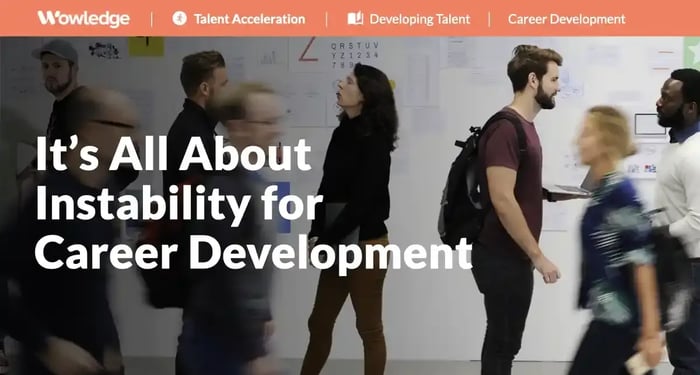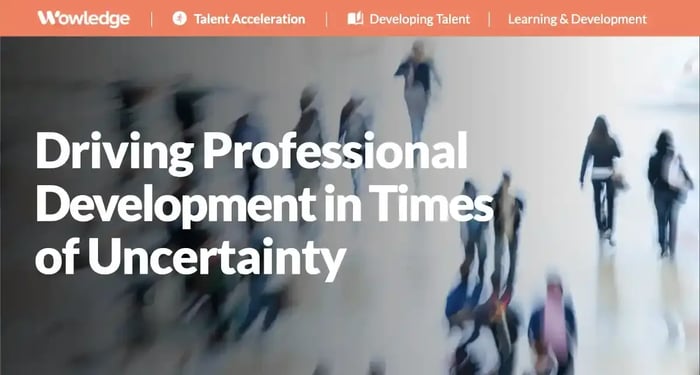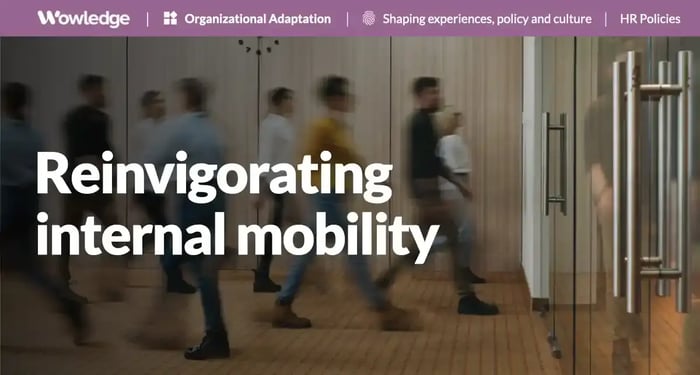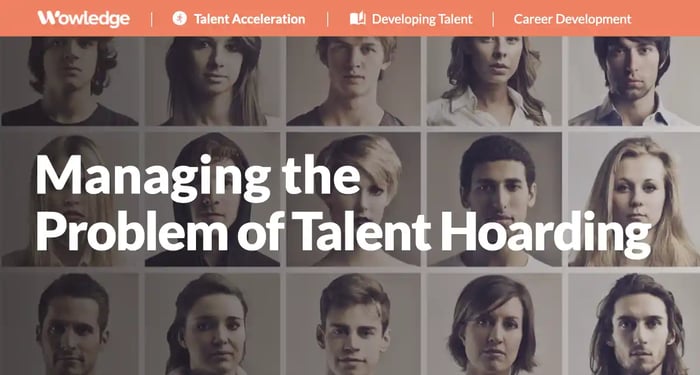Table of Contents
With all the difficult news surrounding the labor markets—layoffs by industry leaders, resistance to returning to (non-remote) work, continuing labor shortages, “quiet quitting”, and the latest workplace phenomena—one must wonder what a company must do to ensure it has the staff resources necessary to meet its targets. Where does career development fit in?
It is all about stability in the workplace, right? An engaging culture, sound leadership practices, ongoing fairness, equity, an acceptance of diversity, a low-to-moderate stress environment, task or role autonomy, a consistent sense of belonging, and so on.
Actually, it’s not. Well, not completely. People may want stability, but one key aspect that drives retention is individual development and growth. An employee’s sense of movement in their skills, knowledge base, and capabilities. A consciousness of true growth. A feeling that the organization is feeding its ambitions.
One of our favorite metaphors is an old sailing trope, “stability through motion,” which relates to how solid you feel on the deck of a boat when the wind is strong and the sails are properly trimmed. Even accounting for high waves, under those conditions, the boat is more stable than in light winds. Career development is all about that kind of motion, of movement forward, directed and under control, towards a fulfilling future.

The challenges and opportunities facing career development
There are a number of issues that challenge today’s organizations as they work to create and deliver on career development’s promise.
1. It is often ill-defined
We talk about career development, but often lack precision and formal processes that clearly define and support its communication. Career development (or management) should be defined and communicated broadly as a process equally core to the employee experience as learning and development, leadership development, performance management, and other talent processes. It is defined here as “the processes and practices by which employees continually develop and hone the skills, knowledge, and abilities that propel them to both expanded and new roles over the course of a career”.
It should be further defined by what it includes. Our perspective on career development includes all activities (formal and informal) that help an employee:
- Identify their aspirations and the matches between those and their skillsets with roles, functions, and strategic direction/initiatives in the company.
- Acquire new knowledge, skills, and abilities related to those roles and functions.
- Access guidance from knowledgeable experts in their career field and any others to which they aspire.
- Garner experience in the tasks and activities related to the roles and functions to which they aspire.
- Gain exposure to and active consideration from the leaders and teams who hire, manage and develop people in those targeted (aspirational) roles and functions.
It is also defined in part by how it integrates with other talent processes, which as we can see, are many:
- Learning & Development (L&D), which provides skill training and development activities.
- Performance Management engages managers and employees in career coaching discussions and development planning associated with the outputs of those discussions.
- Succession Management, which assesses and identifies individual potential for new and upgraded roles and conducts development gap assessments and job rotation/escalation possibility discussions for selected individuals on an annual basis.
- Leadership Development identifies and fills in knowledge, skill, ability, and experience gaps for selected groups of leaders above a certain level.
- Total Compensation provides job requirements and leveling that can be used to identify lateral or promotional roles that share similar skill and competency requirements.
- Talent Mobility provides policies and processes for employees to apply for and gain consideration for internal transfers.
- Recruiting has systems and processes that define and promote currently available roles, with job postings and associated requirements that are accessible by current employees seeking new opportunities.
- Workforce Planning generates insights into both new and future roles (and ideally, volumes needed) that will be available and required to fulfill business objectives and initiatives.
As a result, a well-crafted definition should be articulated and promoted throughout the organization for both clarity and a shared understanding.
2. It lacks clarity of ownership and responsibility
Unlike other development capabilities (L&D, Leadership Development) which may be freestanding departments within the HR function and thus often have a dedicated leader and/or staff, career development often lacks a process owner or dedicated staff. Much like succession management, it is often the purview of some combination of the HR business partners (HRBP), L&D staff, functional managers, and line leadership.
To bring this into line, consider assigning this responsibility to a senior HR leader (or governance council) who can effectively build capabilities and systems that tie all the associated processes, resources, and people together. For example, the new leader/council can develop processes that train and engage managers as stronger career coaches, suggest matches of employees to roles, and/or suggest training that maps current skills with those needed for newly targeted roles (both using modern technology), and integrate the processes that make up a career development ecosystem.
Such an individual/council can also develop a strategy in partnership with top leadership to create a culture of development and mobility, where managers are trained, coaxed, and rewarded for being developers of people, as net producers of future promotes and cross-business and -functional transfers. This can be augmented by adopting a recurring talent review process in line with either the performance management and/or succession planning processes, where all employees’ performance, capabilities, prospects, and readiness for a new role are discussed. In this way, the managers participate as community builders by actively assessing and recommending career moves by employees for developmental purposes, with the goal being the building of company-wide skill bases.
This takes us to the role of the employee. An additional step from a process perspective is the use of talent profiles that are updated by the employee annually. These are necessary fodder for the latest career development and learning mapping and matching technologies, and should include the employee’s education and experience, skill listing (and level assessment), critical experiences, and other key information needed to enable a level playing field in terms of identifying employees as potential successors, candidates for critical roles, and their general development opportunities.
A personal note/opinion on the oft-taken corporate position that career development is the responsibility of employees - it is a cop-out by leadership. Providing tools and templates to employees is one step, but active participation and encouragement by leadership and managers is a must-have to activate a true culture of development and mobility.
At the end of the day, clarity needs to be provided about the role of leaders, managers, and members of the HR team, with responsibility ultimately shared between them and the employee.
3. It is not well-linked to business needs
What is often lacking is clarity regarding where the organization is directing people from a skills and capabilities priorities standpoint. Leadership needs to be clear about its priorities from a future skills perspective. Just as it is leading practice to communicate corporate direction, objectives, and initiatives, so should be the communication of future skill requirements.
Employees need guidance, and should be informed on an annual basis that the enterprise goals are dependent upon having a sufficient volume of space propulsion engineers, or data scientists, or ICU or oncology nurses. The same goes for sharing with employees what skills will be the most in-demand in the future and gives them time to develop what is needed to meet those requirements if they aspire to them. Other guidance is needed to connect managers and employees of functions that are likely to be downsized in the future due to technology (e.g., AI, machine learning, robotics) adoption.
This is related to a workforce planning capability, which produces supply and demand forecasts based upon future business needs on the “demand” side, with internal workforce and external labor market trends providing the “supply” side data. The combination of such business planning and communications with employees and managers can drive significant action on the part of employees to upskill and leverage company resources to do so.
One other method to leverage for a stronger business-career development linkage is critical workforce segmentation (CWS) analysis. A CWS exercise categorizes every job in the company by its business criticality and scarcity in the labor market. Such an analysis can identify those roles where a robust and active career development strategy can be applied on a more cost-effective basis, by focusing more career resources and efforts on fewer (5-10%) roles. Such an effort can prioritize future role holders’ development in the functions where the greatest return on investment can be achieved.
4. It has an unclear value proposition
Careers develop over dozens of years, and employees in leadership or critical roles come and go every few years. Add to that business cycles that go up and down over such timeframes, and the incentive to make investments in career development can rise and fall as those cycles drive budget cuts that need to be made somewhere. Long-term thinking is not necessarily a strength in every administration of every company over time.
The realities require action and long-term thinking. The most valuable asset that can be deployed is the HR Metrics and Reporting or a People Analytics function. Through the initial use of even the most basic statistics, followed by an evolution towards more advanced analytic methods, a business case can be made for keeping the career development machine in operation.
Start with efficiency and effectiveness measures such as:
- Percentage of employee transfers during the year.
- Number of promotions into a new department or function.
- Percentage of critical skills employees with a development plan.
- Percentage of employees who have a completed Talent Profile.
- Percentage of employees who applied for new jobs internally.
And then evolve onto talent – or business-outcome-focused metrics:
- Critical Skill and High Potential Employee turnover rate.
- Average number of transfers or promotions out per manager (“talent producer”).
- Percentage of named successors who were placed in the executive role.
- Percentage of critical skills needed vs. filled/in place during the year.
- Percentage of critical skills roles filled in-house.
5. Career pathways are most frequently unclear and inaccessible
The final point is that career paths are often fuzzy creatures – they are informal, irregular, and rely on word of mouth for transmission. These need to be defined and communicated such that employees can see what lies in front of them and what they might aspire to. Today’s HR Information Systems (HRIS) and Talent Management Systems (TMS) offer the capabilities to build these so that employees, managers, and HR leaders alike can review and use them.
When those are being built, the career pathway should include not only upward/vertical growth but lateral or lattice moves that take into consideration common competencies and skill overlaps that can help identify cross-functional moves that may be attractive to some employees. AI and machine learning technologies are also now capable of producing draft ladders or lattices that can be used to articulate realistic pathways for employees.
Lacking a system or resources to produce those, these can be created on a smaller scale based on experience (e.g., pathways that successful VPs or senior individual contributors took), common competencies across roles (e.g., college courses in statistics and HR survey reporting experience could lead to a business analytics role). These can be created done at a functional, business unit, or location basis.
Movement is the key
So maybe it’s NOT about instability after all - that may have been somewhat inaccurate. Career development IS about continual and controlled motion, the kind that sailors work towards even as they encounter low winds, stormy seas, or the side-to-side tacks they take to stay on course with favorable winds.
It’s the HR Pioneer’s role to figure out how to tie all of the education and development pieces and integrations into an effective package that offers (and incentivizes) continual development of employee skills and capabilities. Keep in mind that in the collective, these steps are designed to develop key business capabilities that enable the achievement of long-term business objectives.
Good luck on your journey and “fair winds and following seas”!
Relevant Practices & Tools
Core Career Development Practices that Translate Employee Ambitions into Occupational Progression Action Plans. >
Core Career Development is a process through which employee development is guided towards a targeted series of successive job roles that build upon one another and provide continued growth and challenge over the years... more »
Constructing Career Paths to Identify Future Aspirational Roles. >
A career path (or “ladder”) is a logical progression of increasingly challenging jobs within a specified function that primarily includes vertical movement throughout an organization and requires progressively more experience and skills... more »
Defining Career Lattices to Define Robust Lateral and Vertical Mobility. >
The ability to enable the movement of employees proactively and strategically from role to role at the leadership, professional, and operational levels is a key flexibility that advanced career development functions offer... more »
Creating Informal Learning and Experiential Development Opportunities for Cost-effective Delivery. >
Informal learning includes any learning or development activity that a) takes place outside of a formal classroom or educational setting, b) is self-initiated or guided, and c) aims to improve or develop practical knowledge, skills, and abilities (KSAs) for a current job or aspirational role... more »
The Individual Development Plan (IDP) Tool: Capture Targeted Employee Learning and Development Actions for a Performance Period. >
A plan of action to guide the employee throughout the coming performance period (e.g., year) as they continue to develop necessary knowledge, skills, abilities, and competencies for both meeting current and preparing for future job role requirements... more »
FAQs
Which manager behaviors most reliably increase internal movement without causing churn?
Managers who conduct structured career conversations, sponsor targeted stretch assignments, and make timely internal referrals tend to produce higher internal mobility. Providing clear role outcomes, feedback tied to skill standards, and proactive exposure for employees to other hiring leaders creates movement while preserving team performance. Encourage, reward, and recognize managers who are “net producers” (vs. “hoarders”) of workers who transfer out of or earn promotions from their teams. Tracking internal fills, transfers out per manager, and successor readiness ensures behaviors are rewarded and replicated.
How can organizations build career pathways that go beyond linear promotions?
Effective pathways map both vertical progression and lattice moves across adjacent functions based on common competencies and transferable experiences. Each node should specify the minimum and preferred skills, critical experiences, and typical time-in-role so employees can plan realistic transitions. Where systems are limited, promote exemplary case studies of career moves (e.g., how they developed, networked, and were mentored) from successful internal moves, and how competency skill overlaps were leveraged to provide usable guidance until technology matures.
What technology capabilities are most valuable for a career development ecosystem?
High-impact capabilities include searchable talent profiles, skills inference or validation systems, role and skill taxonomies and databases, internal job marketplaces, and recommendation engines for learning and project opportunities. Integration with performance, learning, and recruiting systems enables seamless updates and reduces manual upkeep. Adoption improves when tools are embedded in daily workflows and deliver personalized, timely nudges rather than static libraries.
How can employees be engaged as active participants without shifting responsibility away from leaders?
Clear expectations should be communicated and incorporated into performance standards for annual profile updates, skill self-assessments, and participation in targeted learning to maintain employee visibility to opportunities while preserving manager and HR accountability. Managers should be equipped to coach and sponsor, not merely direct employees to tools, and leaders should be evaluated on their ability to develop talent for the enterprise. Transparent access to new roles, career pathways, development opportunities, and selection criteria ensures fairness and sustains trust in the system.










